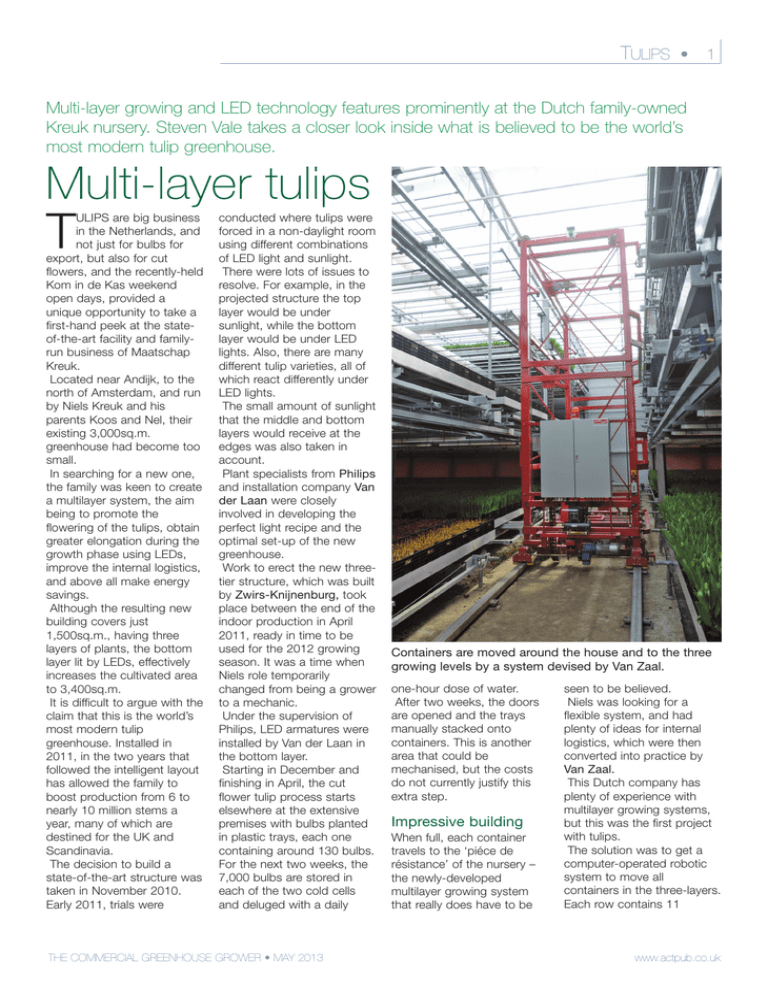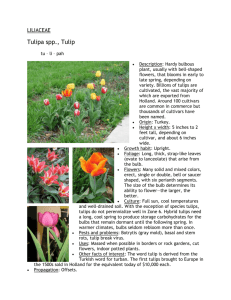Layout 1 (Page 15)
advertisement

TULIPS • 1 Multi-layer growing and LED technology features prominently at the Dutch family-owned Kreuk nursery. Steven Vale takes a closer look inside what is believed to be the world’s most modern tulip greenhouse. Multi-layer tulips ULIPS are big business in the Netherlands, and not just for bulbs for export, but also for cut flowers, and the recently-held Kom in de Kas weekend open days, provided a unique opportunity to take a first-hand peek at the stateof-the-art facility and familyrun business of Maatschap Kreuk. Located near Andijk, to the north of Amsterdam, and run by Niels Kreuk and his parents Koos and Nel, their existing 3,000sq.m. greenhouse had become too small. In searching for a new one, the family was keen to create a multilayer system, the aim being to promote the flowering of the tulips, obtain greater elongation during the growth phase using LEDs, improve the internal logistics, and above all make energy savings. Although the resulting new building covers just 1,500sq.m., having three layers of plants, the bottom layer lit by LEDs, effectively increases the cultivated area to 3,400sq.m. It is difficult to argue with the claim that this is the world’s most modern tulip greenhouse. Installed in 2011, in the two years that followed the intelligent layout has allowed the family to boost production from 6 to nearly 10 million stems a year, many of which are destined for the UK and Scandinavia. The decision to build a state-of-the-art structure was taken in November 2010. Early 2011, trials were T conducted where tulips were forced in a non-daylight room using different combinations of LED light and sunlight. There were lots of issues to resolve. For example, in the projected structure the top layer would be under sunlight, while the bottom layer would be under LED lights. Also, there are many different tulip varieties, all of which react differently under LED lights. The small amount of sunlight that the middle and bottom layers would receive at the edges was also taken in account. Plant specialists from Philips and installation company Van der Laan were closely involved in developing the perfect light recipe and the optimal set-up of the new greenhouse. Work to erect the new threetier structure, which was built by Zwirs-Knijnenburg, took place between the end of the indoor production in April 2011, ready in time to be used for the 2012 growing season. It was a time when Niels role temporarily changed from being a grower to a mechanic. Under the supervision of Philips, LED armatures were installed by Van der Laan in the bottom layer. Starting in December and finishing in April, the cut flower tulip process starts elsewhere at the extensive premises with bulbs planted in plastic trays, each one containing around 130 bulbs. For the next two weeks, the 7,000 bulbs are stored in each of the two cold cells and deluged with a daily THE COMMERCIAL GREENHOUSE GROWER • MAY 2013 Containers are moved around the house and to the three growing levels by a system devised by Van Zaal. one-hour dose of water. After two weeks, the doors are opened and the trays manually stacked onto containers. This is another area that could be mechanised, but the costs do not currently justify this extra step. Impressive building When full, each container travels to the ‘piéce de résistance’ of the nursery – the newly-developed multilayer growing system that really does have to be seen to be believed. Niels was looking for a flexible system, and had plenty of ideas for internal logistics, which were then converted into practice by Van Zaal. This Dutch company has plenty of experience with multilayer growing systems, but this was the first project with tulips. The solution was to get a computer-operated robotic system to move all containers in the three-layers. Each row contains 11 www.actpub.co.uk 2 • TULIPS Each tray is filled with 3.5lit of water a day. 1.5lit remains in the bottom of each tray. The remaining 2lit is drained and recycled. Air ducts provide an ideal solution to heat or cool the bottom and second layers. containers (around 25,000 tulips). Travelling along two tracks in the central aisle, the lift system quickly moves containers into position on until the end of March, the building is crammed with tulips. When a container from the cold cell is brought into the new greenhouse it spends both sides of the greenhouse. My visit took place towards the end of the season, so not all three layers were full. However, from December » www.actpub.co.uk » nearly a week acclimatising at the second (unlit) level. This is followed by a week at the bottom of the greenhouse, after which the container is elevated to the » THE COMMERCIAL GREENHOUSE GROWER • MAY 2013 TULIPS • 3 top of the structure for one final week. Finally, when the bulbs start budding they are returned to the bottom layer on one side of the house in what is internally dubbed the waiting layer. Depending on weather, 5-6 weeks after planting, the bulbs are then ready to be sent back into the existing and adjacent 3,000sq.m. greenhouse for harvesting. Water and heating Moving the containers is just one part of the system. The growing bulbs also need to be irrigated. The computerised ebb and flood irrigation system was installed by Ateco, and a technique that deluges each container at least once a day for six minutes with fresh water. Each tray is filled with 3lit of water, which then slowly drains to leave a small 1.5lit layer of water in each tray. The excess 2lit is recycled and disinfected using UV light. The best way to heat the new greenhouse, and to keep this as close as possible to 16.5 degrees C, also needed careful planning. In the end, the decision was taken to use low temperature boilers. In practice, they tend to heat water to a temperature from 40 to 50 degrees C, and the maximum temperature the boiler operates to is 50-60 degrees C. Previously, they use to heat their water to 90 degrees C. While the top plant layer is warmed using standard heating pipes, the bottom two tiers are heated using air ducts, which run the full Once the containers leave the new multilayer greenhouse the plants are pulled from the trays and placed onto a conveyor belt. length of the building. In the capable hands of Van Zaal, and using climate control computers from Hoogendoorn Growth Management, the system provides them with the possibility to suck in outside air to alter moisture levels. The heating and cooling, and irrigation systems are indeed state-of-the-art. WINN ER Best ne w prod uc t / ser Four Oa vice award – k s Trad e S h ow 2011 Best ne w non-pla prod uc nt t awa West G rd – South rowe r s Sh ow 2 011 Advanced Protection for Growing Returns Untreated Protected Phytophthora wreaks havoc on growers, potentially destroying the entire crop. On average, growers report losses of 10%. PlantTrust controls the release of fungicide and fertilizer, protects against phytophthora, giving the plant exactly what it needs. 3 Increased number of sellable plants 3 Easy to use 3 Optimum root uptake tailored to the plant’s needs 3 Stronger, healthier plants 3 No contact with the active ingredient 3 Reduced labour costs 3 Reduced spray records, COSHH assessments and no PPE required FREE PHYTOPHTHORA TEST! Concerned about levels of phytophthora in your nursery? Arrange your FREE test or find out more about PlantTrust at www.planttrust.co.uk Everris Limited, Epsilon House, West Road, Ipswich IP3 9FJ, Tel: 0844 8094470, Fax: 01473 237150, E-mail: prof.sales@everris.com, www.everris.co.uk ® Registered Trade Marks of Everris Limited or its affiliates. PlantTrust contains fosetyl-aluminium. Use plant protection products safely. Always read the label and product information before use. THE COMMERCIAL GREENHOUSE GROWER • MAY 2013 www.actpub.co.uk 4 • TULIPS Niels Kreuk (pictured above) reckons the new multilayer greenhouse is allowing him to increase stem quality, boost production, and make great energy savings. Made by Potveer Machines, the newly-installed Quality Buncher handles an average of 1,000 to 1,200 bunches per hour (top right). However, the LED lights tend to enjoy most of the attention at this nursery. The lowest of the three layers is fitted with Philips GreenPower LED production modules, which emit deepred and blue light. “This combination was selected because the red light provides excellent growth for the tulips while the blue light has a positive influence on plant growth, producing a better stem length,” explains Niels. The blue lights are coated with phosphate which, to the naked eye, gives the www.actpub.co.uk appearance of white light. This is important because if the lights were blue and red then it would be very unpleasant for staff to work in the building. On one side of the central passageway the two strings of LEDs generate a light level of 18 mmols/m. On the other, in the waiting bed area, light levels are increased to 27mmols/m using three LED strings, simply because fully grown plants need more light. Niels is impressed by the results of the LEDs when compared to fluorescent lighting. “The operating costs/sq.m. are lower because LEDs have a much longer lifespan than a fluorescent solution and therefore needs less relamping. This in turn results in lower labour costs.” He says LEDs also lead to a tremendous difference in energy costs. One 35-watt LED module replaces the normal situation with two fluorescent tubes of 58 watts each. “This represents an electricity saving of 65%,” he adds. “They also have a positive effect on the crop, the tulips have a deeper green colour and greater elongation.” In fact, while the use of LEDs leads to a better quality product, it is the overall energy saving that is the other big benefit of the multilayer system. Niels reckons that while he produced an extra 1.8 times more tulips last year, he used 20% less gas. “Overall, I reckon the energy saving is in the region of 30% because of the use of electricity for lighting,” he adds. The amount of manual work has been reduced to a minimum at this nursery. The only job that needs to be done in the multilayer greenhouse is to pull off the outer skins as the bulb starts to grow (a task that could also be automated). If they do not do this then it could stick to the bulb preventing the stem from growing. New bunching machine manual affair, but in the sorting and packing department, the tulips pass onto another brand new machine. Installed by Potveer Machines, Niels describes the Quality Buncher as an affordable way to make major labour costs savings, the early results pointing to an average capacity of 1,000 to 1,200 bunches per hour, and at peak capacity as many as 1,400 during the same hour. By the time this issue appears, then the multilayer greenhouse will have been shut down for the summer, the focus switching to the company’s 17ha production site on heavy clay land in the Flevoland. Working with 15 different cultivars, the grower tries to be self-sufficient in tulips. Once the stems have been removed, the bulbs from the cut flower process will be planted in the ground. It will be another two years before they return to the multi-layer ◆ greenhouse. Pulling the bulbs out of the trays and placing them onto a conveyor belt remains a THE COMMERCIAL GREENHOUSE GROWER • MAY 2013

